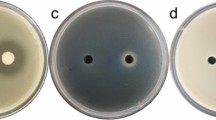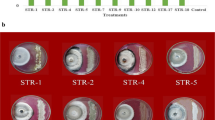Abstract
Xanthomonas oryzae (Xoo) causes bacterial blight in rice, which reduces crop yield and leads to significant economic damage. Xoo exerts its pathogenicity by biofilm formation, interfering with sap flow in the xylem vessels. Inhibition of Xoo biofilm formation may therefore alleviate the symptoms of bacterial blight and restore rice yields. Streptomyces spp. are soil bacteria that produce various secondary metabolites. In the present study, 38,888 extracts derived from Streptomyces spp. were screened for their ability to inhibit Xoo biofilm formation; four extracts exhibited strong inhibitory activity. Separation and purification of the extracts from strains 0320 and 4359 suggested that anthranilamide was the chemical responsible for this effect. Anthranilamide was found to inhibit biofilm formation without affecting Xoo cell growth; it is, therefore, a good candidate chemical for the treatment of bacterial blight in rice as it will not give rise to resistant bacterial strains. The selected four Streptomyces strains were also good candidates for biological treatment of bacterial blight in rice.



Similar content being viewed by others
References
Gnanamanickam SS, Priyadarisini VB, Narayanan NN, Vasudevan P, Kavitha S (1999) An overview of bacterial blight disease of rice and strategies for its management. Curr Sci India 77:1435–1443
Singh RA, Das B, Ahmed KM, Pal V (1980) Chemical control of bacterial leaf blight of rice. Trop Pest Manag 26:21–25
Mew TW, Vera Cruz CM, Medalla ES (1992) Changes in race frequency of Xanthomonas oryzae pv. oryzae in response to rice cultivars planted in the Philippines. Plant Dis 76:1029–1032
Ji G-H, Wei L-F, He Y-Q, Wu Y-P, Bai X-H (2008) Biological control of rice bacterial blight by Lysobacter antibioticus strain 13-1. Biol Control 45:288–296
Velusamy P, Immanuel JE, Gnanamanickam SS, Thomashow L (2006) Biological control of rice bacterial blight by plant-associated bacteria producing 2,4-diacetylphloroglucinol. Can J Microbiol 52:56–65
Han S-W, Park C-J, Lee S-W, Ronald P (2008) An efficient method for visualization and growth of fluorescent Xanthomonas oryzae pv. oryzae in planta. BMC Microbiol 8:164
Mew TM, Alvarez AM, Leach JE, Swings J (1993) Focus on bacterial blight of rice. Plant Dis 77:5–12
Poovarasan S, Mohandas S, Paneerselvam P, Saritha B, Ajay KM (2013) Mycorrhizae colonizing actinomycetes promote plant growth and control bacterial blight disease of pomegranate (Punica granatum L. cv Bhagwa). Crop Prot 53:175–181
Palaniyandi S, Yang S, Zhang L, Suh J-W (2013) Effects of actinobacteria on plant disease suppression and growth promotion. Appl Microbiol Biotechnol 97:9621–9636
Wiggins BE, Kinkel LL (2005) Green manures and crop sequences influence potato diseases and pathogen inhibitory activity of indigenous streptomycetes. Phytopathology 95:178–185
Inbar E, Green S, Hadar Y, Minz D (2005) Competing factors of compost concentration and proximity to root affect the distribution of streptomycetes. Microb Ecol 50:73–81
Cao L, Qiu Z, You J, Tan H, Zhou S (2005) Isolation and characterization of endophytic streptomycete antagonists of fusarium wilt pathogen from surface-sterilized banana roots. FEMS Microbiol Lett 247:147–152
Nithyanand P, Thenmozhi R, Rathna J, Pandian S (2010) Inhibition of Streptococcus pyogenes biofilm formation by coral-associated actinomycetes. Curr Microbiol 60:454–460
You J, Xue X, Cao L, Lu X, Wang J, Zhang L, Zhou S (2007) Inhibition of Vibrio biofilm formation by a marine actinomycete strain A66. Appl Microbiol Biotechnol 76:1137–1144
Kim Y-G, Lee J-H, Kim C-J, Lee J-C, Ju Y, Cho M, Lee J (2012) Antibiofilm activity of Streptomyces sp. BFI 230 and Kribbella sp. BFI 1562 against Pseudomonas aeruginosa. Appl Microbiol Biotechnol 96:1607–1617
Augustine N, Peter AW, Kerkar S, Thomas S (2012) Arctic actinomycetes as potential inhibitors of Vibrio cholerae biofilm. Curr Microbiol 64:338–342
Park SB, Lee IA, Suh J-W, Kim J-G, Lee CH (2011) Screening and identification of antimicrobial compounds from Streptomyces bottropensis suppressing rice bacterial blight. J Microbiol Biotechnol 21:1236–1242
Shaw JJ, Dane F, Geiger D, Kloepper JW (1992) Use of bioluminescence for detection of genetically engineered microorganisms released into the environment. Appl Environ Microbiol 58:267–273
Tsuge S, Furutani A, Fukunaka R, Oku T, Tsuno K, Ochiai H, Inoue Y, Kaku H, Kubo Y (2002) Expression of Xanthomonas oryzae pv. oryzae hrp genes in XOM2, a novel synthetic medium. J Gen Plant Pathol 68:363–371
Jones KL (1949) Fresh isolation of actinomycetes in which the presence of sporogenous aerial mycelia is a fluctuating charateristic. J Bacteriol 57:141–145
Kim T-J, Young BM, Young GM (2008) Effect of flagellar mutations on Yersinia enterocolitica biofilm formation. Appl Environ Microbiol 74:5466–5474
Biabani MAF, Baake M, Lovisetto B, Laatsch H, Helmke E, Weyland H (1998) Anthranilamides: new antimicroalgal active substances from a marine Streptomyces sp. J Antibiot 51:333–340
Acknowledgments
This research was supported by “Cooperative Research Program for Agriculture Science and Technology Development (Project No. PJ013896032018)” Rural Development Administration, Republic of Korea.
Author information
Authors and Affiliations
Corresponding author
Electronic supplementary material
Below is the link to the electronic supplementary material.
Rights and permissions
About this article
Cite this article
Ham, Y., Kim, TJ. Anthranilamide from Streptomyces spp. inhibited Xanthomonas oryzae biofilm formation without affecting cell growth. Appl Biol Chem 61, 673–680 (2018). https://doi.org/10.1007/s13765-018-0405-1
Received:
Accepted:
Published:
Issue Date:
DOI: https://doi.org/10.1007/s13765-018-0405-1




